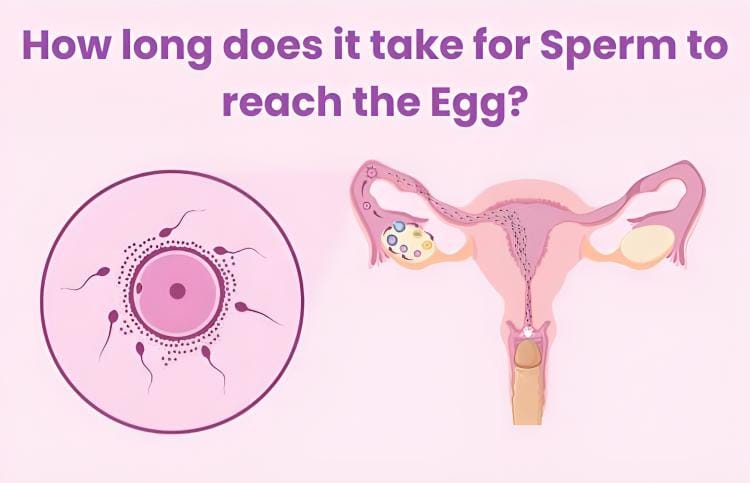Table of Contents
How long does it take for Sperm to reach the Egg?
Fertilization, the process where a sperm cell fuses with an egg, is a crucial step in human reproduction. This journey of sperm to the egg, while often taken for granted, involves an intricate process that depends on timing, anatomy, and other biological factors. In this blog, we will explore how long it takes for sperm to reach the egg, the factors influencing this time frame, and the process of conception.
Read More: How Long Does It Take for a Sperm to Fertilize an Egg?
The Journey of the Sperm
Once sperm is ejaculated into the female reproductive system, its primary goal is to fertilize the egg. This journey begins in the vagina which proceeds through the cervix, and reach to the fallopian tubes. It is where fertilization typically occurs. The sperm’s movement is aided by muscular contractions of the uterus and chemical signals from the egg.
How Long it will take for Sperm to Reach the Egg?
In an ideal scenario, sperm can reach the egg within minutes after ejaculation, but the journey can take up to several hours. On average, sperm reaches the fallopian tubes in about 30 minutes to 2 hours after ejaculation. However, the exact timing can vary due to factors such as sperm motility (how fast and effectively sperm swim), the woman’s reproductive health, and the presence of fertile cervical mucus, which can help sperm navigate through the reproductive tract more efficiently.
How Long Does It Take for Sperm to Reach the Egg and Get Pregnant?
While sperm may reach the egg in as little as 30 minutes, actual pregnancy depends on a few additional steps. After the sperm reaches the egg, the sperm must penetrate the egg’s outer layer, known as the zona pellucida, in a process called capacitation. This can take several more hours, and fertilization typically occurs within 12-24 hours after ejaculation.
Once fertilization occurs, the fertilized egg (zygote) must travel back to the uterus, where it implants in the uterine lining. This implantation process can take another 6-10 days, at which point pregnancy is officially established.
Sperm Survival and Timing
Sperm has a surprisingly long survival window within the female reproductive system. Under optimal conditions, sperm can live for up to 5 days inside a woman’s reproductive system. It will happen, especially if fertile cervical mucus is present. This means that even if intercourse takes place a few days before ovulation, there’s still a possibility of conception.
However, the egg only remains viable for fertilization for about 12-24 hours after it is released during ovulation. Therefore, the timing of intercourse in relation to ovulation plays a critical role in determining how long it takes for sperm to reach the egg and result in pregnancy.
The Role of Ovulation in Fertilization
How Long it take for Sperm to Reach the Egg during Ovulation?
During ovulation, the female body is primed for fertilization.There will be a release of a mature egg from the ovaries, and this occurs roughly in the middle of the menstrual cycle. It willtake around day 14 of a 28-day cycle. Once the egg is released, it will go into the fallopian tube, where it ight meet with sperm.
If intercourse occurs during ovulation, sperm can reach the egg within minutes to hours after ejaculation. Given that the egg is ready for fertilization during this time, fertilization is more likely to occur quickly, provided the sperm is healthy and motile.
The fertile window is the period when pregnancy is most likely to occur, and it spans 5-6 days: the day of ovulation and the few days leading up to it. During this time, sperm can remain viable and wait for the egg to be released, increasing the chances of successful fertilization.
Factors That Affect How Quickly Sperm Reaches the Egg
- Sperm Motility: Sperm that moves faster and more efficiently has a better chance of reaching the egg sooner. Poor motility can delay or even prevent sperm from reaching the egg at all.
- Cervical Mucus: Fertile cervical mucus, which is more slippery and abundant during ovulation, aids sperm in its journey to the egg by creating a more conducive environment for movement.
- Female Reproductive Health: Any issues with the female reproductive system, such as blockages in the fallopian tubes or hostile cervical mucus, can slow down or prevent sperm from reaching the egg.
- Sperm Count: A higher sperm count increases the likelihood of sperm reaching the egg in a timely manner, as there are more sperm available to navigate the female reproductive tract.
- Timing of Intercourse: The timing of intercourse in relation to ovulation is one of the most significant factors. Intercourse during the fertile window maximizes the chances of sperm reaching the egg quickly.
Fertilization and Implantation
Even after the sperm reaches the egg, pregnancy doesn’t happen immediately. Fertilization is the next step, where a single sperm penetrates the egg and combines its genetic material with that of the egg. This process triggers a series of cell divisions, forming a zygote. Over the next few days, the zygote develops into a blastocyst and travels toward the uterus for implantation.
Implantation is the final step before pregnancy is established. This occurs when the blastocyst embeds itself into the uterine lining, and it can take 6-10 days after fertilization. The timing of implantation can affect when pregnancy symptoms begin to appear, such as mild cramping or implantation bleeding.
Conclusion
The journey of sperm to the egg is a fascinating process that depends on multiple factors, including timing, sperm health, and the female reproductive environment. The sperm can reach the egg in a matter of minutes to hours and full process of conceptionfrom fertilization to implantationcan take days. Understanding the timing of intercourse in relation to ovulation is key to increasing the chances of pregnancy.
Frequently Asked Questions (FAQs)
- Can sperm survive long enough to wait for ovulation?
Yes, sperm can live for up to 5 days in the female reproductive tract if fertile cervical mucus is present, allowing them to wait for the release of an egg during ovulation.
- What happens if sperm doesn’t reach the egg?
If sperm doesn’t reach the egg, fertilization cannot occur, and pregnancy will not take place. The unfertilized egg will eventually be shed during menstruation
- Can fertilization occur outside the fallopian tubes?
No, natural fertilization occurs in the fallopian tubes. However, assisted reproductive techniques like in vitro fertilization (IVF) allow for fertilization to occur outside the body in a controlled environment.

